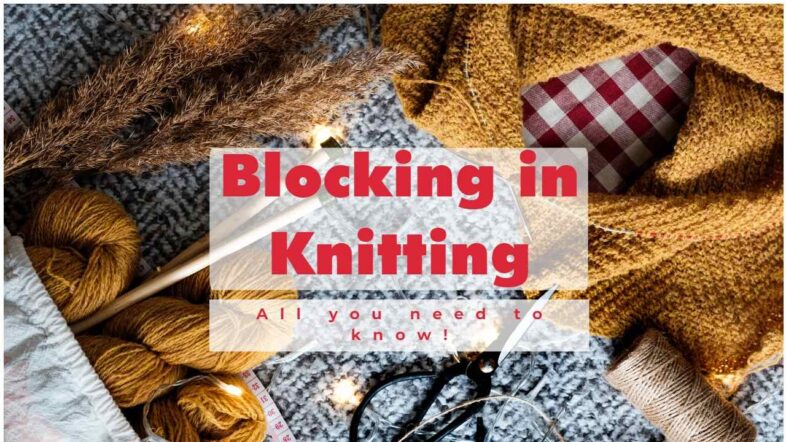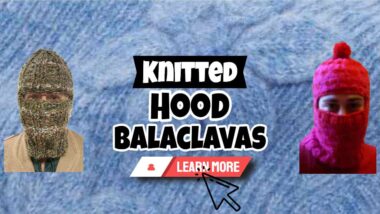Blocking in Knitting is a much-misunderstood technique. In this article, we explain how to do it.
How to Block Your Knitted Projects
Many knitters, both novice and experienced, are afraid of blocking knitted objects.
Although most knitters are aware of the blocking method, many do not use it. It’s a vital last step in knitting, especially if your project doesn’t turn out exactly how you want or need it to. Blocking may help any knitting project that has portions that need to be sewn together, but it’s also great for making projects square and pulling things together better before sewing, as well as to fit and look better.
Blocking is a technique for levelling out a knitted fabric that involves the use of water or steam as well as some reshaping. Knitting things vary in tension because they are finished over a period of days, weeks, or months. On some days, you may feel tired, while on others, you may feel anxious. It might all have an effect on your knitting, especially if you’re just getting started.
Sweaters knit in the round take longer to dry, but it is a necessary step in assuring a proper fit. How do you block sweaters to make them suitable for knitting in the round? Soak the item in cold water for 20 minutes. Meanwhile, use straight pins to measure and outline the basic measurements of the garment.
How to Block Your Knitting
Steam blocking knitwear. Well, it appears that I just can’t stop producing films anymore, haha! Actually, I’d been planning to do this for a while, and yesterday morning I had the ideal mix of knitting that needed to be blocked, time to film a video, and a clear sky! Blocking and finishing are the two most often asked questions about knitting. When I talk about steam blocking, I’m often startled by the moderately astonished reactions I get.
If this is your first time practising these blocking techniques, why not start with a swatch? It is critical to always block your swatch in the same way that you would block your completed product to achieve an exact finishing gauge. Please keep in mind that our instructions are only for blocking wool textiles. Please double-check the manufacturer’s guidelines for proper handling if you are knitting with a different fibre.
Blocking your crochet goods completes the look of your hours of crocheting. While blocking isn’t everyone’s favourite aspect of the job, it significantly improves and beautifies your crochet work. In this Annie’s special edition free video lesson, you’ll learn about blocking techniques and materials that can be used on both crochet and knit projects. This lesson is a combination of blocking instructions from three of Annie’s online classes: crocheting with thread with Susan Lowman, knit finishing methods with Carri Hammett, and lace and openwork knitting workshop with Jill Wright.
Instructions for How To Block Your Knitting
When I first started knitting, I devoured books and articles on every stage of the process. According to all of the sources, blocking your knitted object is one of the final procedures in completing. Despite the fact that I could find several directions on how to block my knitting, none of them addressed why I should block my knitwear or how I would know if I had done it right. As a result, every time I completed knitting anything and faced the prospect of blocking it, I was concerned that I would stretch it out of shape or not block it sufficiently to make it seem “correct.”
Wet blocking This procedure, which is best for robust or bulky sweaters, involves immersing your knitting in water. Check that it is moist rather than damp, but not fully sodden and that the water is not too hot, according to the recommendations on the ball band of your yarn. Drain or tip away from the water and squeeze out any excess moisture carefully.
Blocking in Knitting Your Hand Knits
 Prior to washing, each sweater and knitted clothing should be properly measured. Your sweaters and knits are de-pilled, delinted, and blocked to your original measurements after washing. Blocking entails measuring the dimensions of a garment before washing it. Keeping track of all those dimensions. Using hands and steam, shape the garment to its original proportions. A vacuum is used to “dry” the steam and “lock” the form into place.
Prior to washing, each sweater and knitted clothing should be properly measured. Your sweaters and knits are de-pilled, delinted, and blocked to your original measurements after washing. Blocking entails measuring the dimensions of a garment before washing it. Keeping track of all those dimensions. Using hands and steam, shape the garment to its original proportions. A vacuum is used to “dry” the steam and “lock” the form into place.
To begin, read the yarn label (see below). Typically, care instructions are written down or denoted by symbols (see sidebar below). If the label specifies machine washing and drying, follow these simple steps for easy blocking. Any of the procedures indicated here might be used if the label specifies handwashing and no machine drying. The first option is where you will block your knits and what surface you will use.
This is my preferred blocking technique, especially for machine washable yarns. I put my knits in the washing machine on the mild or hand wash cycle and let the machine do its job. When the wash cycle is through, I notice that the machine wrung out just enough water to leave the knits moist but not wet. This provides a bit more malleability than just stretching out your dry knits and makes it easier for the stitches to fall into an equal pattern.
What blocking can’t do?
Yarn ends that have been well woven in are difficult to un-weave, so I prefer to do this as the very last step. Blocking fluffs up the yarn, giving the yarn ends more traction as I weave them in, ensuring they remain in place. I don’t like to stitch seams until the pieces have been flattened (the edges are smoother and straighter after blocking), and I frequently seam with long yarn ends.
Place the first pin in the top centre and work your way down to the bottom centre as you pin the piece to the proper length. Then, pin your work to the proper width (if blocking a sweater, start with the bust width). Fill in around the edges, referring to your completed dimensions at all times. Allow the artwork to dry naturally. If you use a knitter’s block, the tiles will softly grab your knitting, keeping the garment in place.
Organize your stitches. Methods differ based on the stitch design and fibre used. A cycle in the washer and dryer is required for an acrylic basketweave blanket-blocking. Water does nothing but get synthetics wet, therefore you’ll need heat. A wool lace shawl requires a bath in wool wash and drying on a pin. You’ll block swatches the same way you would the finished garment, so don’t pin the swatch if you won’t be pinning the sweater after washing.
Have you ever looked at your crocheted blanket and thought to yourself, “This isn’t what I want it to look like.” No matter how hard you try, it’s all folded up and wrinkled. How can you improve the way it looks? This is when blocking comes into play. It is the “ultimate” phase of knitting, and it employs a variety of techniques to make your creation more appealing and smooth.
Blocking in Knitting – Conclusion
I like to think of blocking as a little pampering session for your knitting, preparing it to face the world after all of its hard work of creation. Essentially, it relaxes the fibres and evens out your knitting. Natural fibres are highly forgiving, and blocking will complete your knitting. It also allows you to shape the knitting and highlight the nicest parts, such as lace or cables.
So, to summarise, blocking in knitting is a technique that allows a knitter to stretch and shape a piece of knitting to meet the proportions specified by a pattern. Block knitting may assist in making two pieces of knitting adhere to the same size and shape, as well as in evening out the size and shape of the stitches. Some knitting techniques, such as lace, need blocking to bring out the design.


